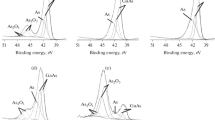Abstract
Electrochemical sulfidation of n-type GaAs (100) has been investigated under anodic conditions with a view to surface passivation for improved electronic and optical properties. This treatment has successfully removed the native oxide and formed a thick layer of gallium and arsenic sulfides displaying high durability against oxidation and optical degradation compared to conventional dipping treatment using (NH4)2S solution. X-ray photoelectron spectroscopy (XPS), Auger electron spectroscopy (AES), secondary ion mass spectroscopy (SIMS) and atomic force microscopy (AFM) have been used to characterize the treated surfaces. These studies have been used to devise a structural model of the near-surface region. The results of Raman backscattering spectroscopy measurements indicate that there is a 35% reduction of the surface barrier height compared to the untreated surface. This passivation technique has been shown to be effective in reducing surface band bending on GaAs (100) and enhancing the chemical stability of the surface, making it more suitable for electronic and optoelectronic device applications.
Similar content being viewed by others
References
V. Malhotra, Electrochem. Soc. Proc. 2, 233 (1996).
V. N. Bessolov, M. V. Lebedev and D. R. T. Zahn, J. Appl. Phys. 82 (5), 2640 (1997).
A. Kapila and V. Malhotra, IEEE, 0–7803–3374–8, 275 (1997).
V. N. Bessolov, E. V. Konenkova and M. V. Lebedev, Tech. Phys. Lett. 22 (9), 749 (1996).
M. S. Carpenter, M. R. Melloch and T. E. Dungan, Appl. Phys. Lett. 53 (1), 66 (1988).
Z. S. Li, X. Y. Hou, W. Z. Cai, W. Wang, X. M. Ding, X. Wang, J. App. Phys. 78 (4), 2764 (1995).
Z. S. Li, X. Y. Hou, W. Z. Cai, W. Wang, M. Zhang, G. S. Dong, X. Jin and X. Wang, Mat. Res. Soc. Symp. Proc. 284, 607 (1993).
X. Y. Hou, W. Z. Cai, Z. Q. HE, P. H. Hao, Z. S. Li, X. M. Ding and X. Wang, App. Phys. Lett. 60 (18), 2252 (1992).
D. J. Olego, R. Schachter, J. A. Baumann, Appl. Phys. Left. 45 (10), 1127 (1984).
C. C. Chang, P. H. Citrin, B. Schwartz, J. Vac. Sci. Technol. 14 (4), 943 (1977).
W. Z. Cai, Z. S. Li, R.Z. Su, G. S. Dong, D. M. Huang, X. M. Ding, X. Y. Hou and X. Wang, Appl. Phys. Lett. 64 (25), 3425 (1994).
S. G. Ershov, A. F. Ivankov, V. V. Korablev and V. Yu. Tyukin, Tech. Phys. Lett. 22 (7), 561 (1996).
X. Hou, X. Chen, Z. Li, X. Ding and X. Wang, Appl. Phys. Lett. 69 (10), 1429 (1996).
Author information
Authors and Affiliations
Rights and permissions
About this article
Cite this article
Elbahnasawy, R.F., Mclnerney, J.G., Ryan, P. et al. Anodic sulfidation and model characterisation of GaAs (100) in (NH4)2Sx solution. MRS Online Proceedings Library 573, 265–270 (1999). https://doi.org/10.1557/PROC-573-265
Published:
Issue Date:
DOI: https://doi.org/10.1557/PROC-573-265




